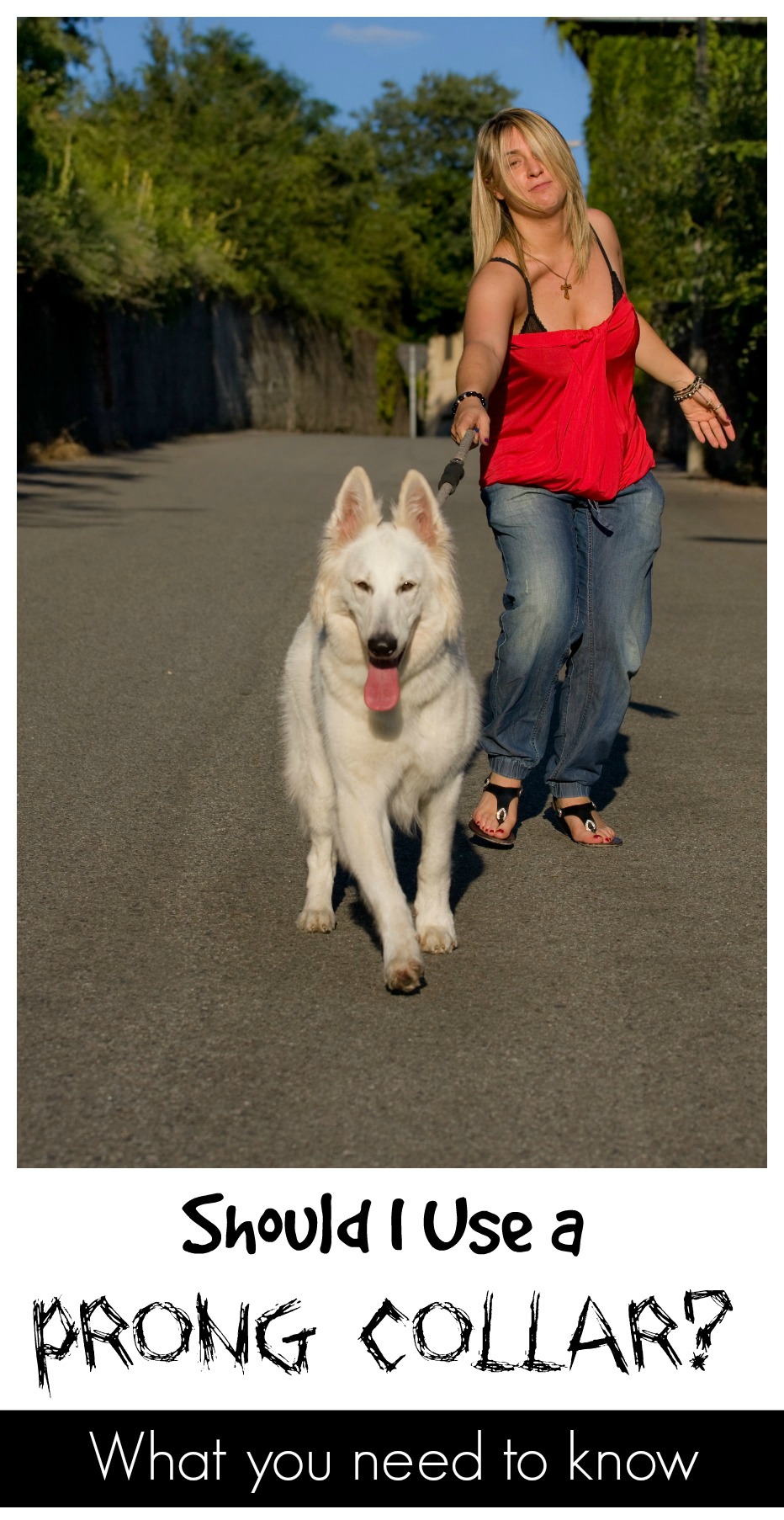
As many of you know, I’m a big animal lover. Ever since I was a small child, they have been a major part of my life and I couldn’t imagine a world without them. There have even been times in my life where our friends and family called our house a ‘petting zoo’ with various rodents, reptiles, cats, and of course, our adorable malamutes. Being from a family of animal lovers, I couldn’t imagine hurting one of our dogs. It actually wasn’t until I was a teenager volunteering at the Daviess County Animal Shelter that I saw one of the most horrible things in my life – a surrendered German shepherd mix with deep gashes in its neck. My heart sank as I looked in that terrified dog’s eyes, as those around me started to treat its wounds. I truly couldn’t understand why anyone would take a knife to such a sweet, beautiful dog, who still came to me wanting love. It was then that I had someone answer my question – it wasn’t a knife, but a prong collar.
What is a Prong Collar
Never heard of a prong collar? For those who had never seen a prong collar, or pinch collar as they are sometimes called, it is a metal chained collar with metal, fang like prongs. When the chain is tightened by the handler or the dog pulls, these collars ‘correct’ the unwanted behavior of pulling by causing the dog discomfort or pain.

Why People Use Prong Collars
So, why would people use something that looks and acts like a torture device? Many people and some very old school trainers think that pain is the best motivator for teaching dogs not to pull on walks or lunge at others, especially children. Once the dog pulls or is pulled, the collars sharp prongs dig in and cause pain, and those who support its use say that dogs will immediately stop this ‘unwanted’ behavior. If you think this looks like a medieval torture device – you’re right! A similar device was used during the middle ages for torture and even some of the worst torturers wouldn’t consider using it.
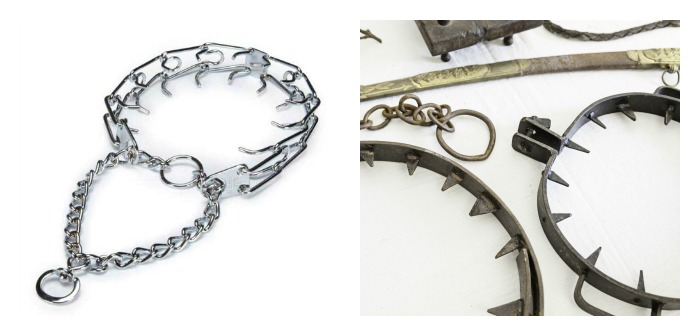
Why Prong Collars Don’t Work
If you noticed, there is one thing I didn’t answer above – if they worked. If your goal is make your dog more aggressive or fearful, the answer is yes. It is something that usually goes with aversion-based training methods. You are teaching your dog to be fearful and do whatever it can to avoid pain. What you aren’t doing is teaching your dog proper behavior, such as not pulling on the leash. If you follow Victoria Stillwell (you know, the famous dog trainer), she makes very clear that choke, pinch, and prong collars shouldn’t be used under any circumstance and goes into quite a few studies talking about the short and long term damage they can do to your dog. Some of the injuries she discusses include:
- Infection from injury and puncture wounds (pictures here and here )
- Spinal cord damage
- Temporary injury, and/or permanent damage to the trachea, esophagus, thyroid gland, lymph nodes, jugular vein, muscles, and spinal column
Lowered immune system defenses (from damage to thyroid glands)
In other words, if you were told by your trainer to use a prong collar to deal with pain – run. Even used ‘properly’, they can cause long term harm, physically and mentally, to your dog.

But My Trainer Said Large Dogs Need Prong Collars
If I had a penny for every time someone told this to me or was shocked that we didn’t use a prong collar with our Alaskan Malamutes. I mean, they pull, right? Of course they pull! For anyone that knows malamutes, they have a very high prey drive and absolutely LOVE to run and play. When its time for a walk, nothing is more exciting and we literally have hopping-at-the-door excitement. Even though Reya is very well trained, she can still pull at times when she gets excited. Puppies are even worse since they grow up so quickly and are just so strong. Ivi is especially concerning since she is terrified of cars and wants to run home the moment she sees one drive by.
That being said, common sense would tell you that using pain to train a dog not to pull (you know, the thing which they were bred to do), isn’t a good idea. I mean, would you really want to make a dog that is as big as a human aggressive or fearful of you? Just like humans, they can only take so much abuse, and they aren’t the type of dogs you want terrified. Even most good breeders for large breeds will tell you to avoid prong collars at all costs and go with positive reinforcement techniques, especially with stubborn, very intelligent breeds like Alaskan Malamutes. Once large dogs are trained, they are delighted to do exactly what you want, especially when they think it will mean longer walks and more playtime!
Prong Collar Alternatives
So, what alternatives are there to prong collars? While saying that positive reinforcement and professional training is great, it can be hard for dog owners who can’t afford training or worry they may not be able to train their dog on their own. There are three products we have used with our own girls that I completely stand behind, with the most successful being the Easy Walk Harness and Gentle Leader. The reason I don’t recommend one above the other is because it mostly depends on your dog’s personality.
Once they have been taught not to pull, I usually upgrade to the Thunder Leash. This leash is more like a collar and leash combination, that gently hugs your dog they try to pull. Since this one does still attach to the collar though, I don’t like using this one until dogs are completely trained not to pull, just to avoid any unnecessary injury, especially with stubborn dog breeds like a malamute.
More Resources
Part of what made me write this article was a discussion that I had with two of my other dog mom friends when a trainer tried defending these collars for large ‘vicious’ breeds. All of us are very passionate about the well being of dogs, no matter their breed, size, or age. They weighed in on this topic as well on their own blogs! Read what they have to say!
Have a large or giant breed dog like us? See why Kelsie MacKenzie says that they are a bad idea too on Its Dog or Nothing. As a mom of two Great Pyrenees and someone who is passionate about the breed, she has her own thoughts on this collar and training methods with our large doggy friends!
Want to know more about the dangers of pain as a training method? See what Carol Bryant has to say about choke and pinch collars on Fidose of Reality. See why she thinks these collars should go straight in the trash!
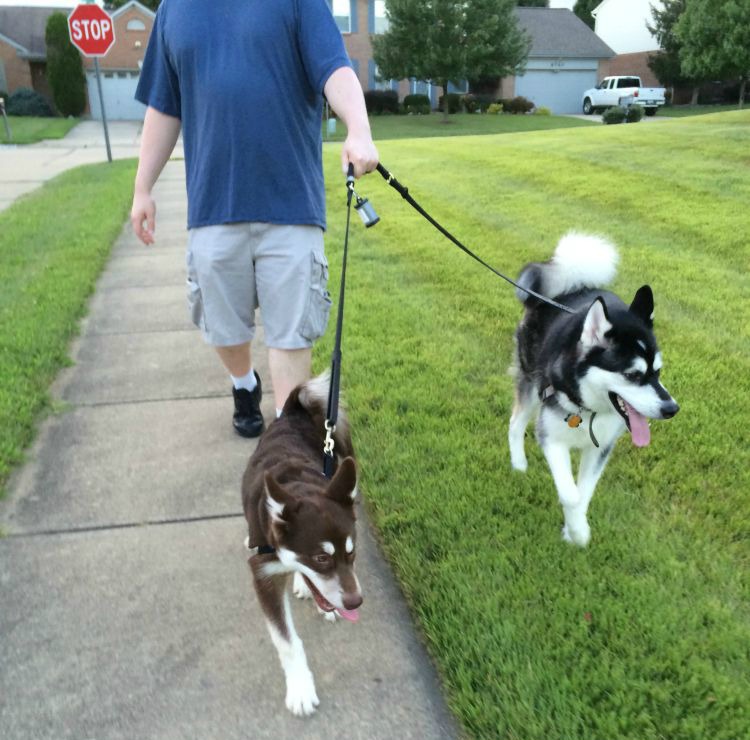

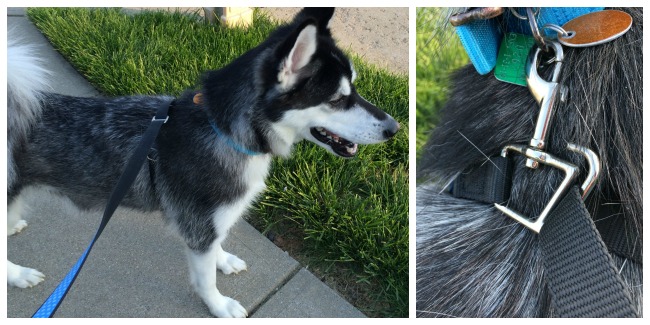
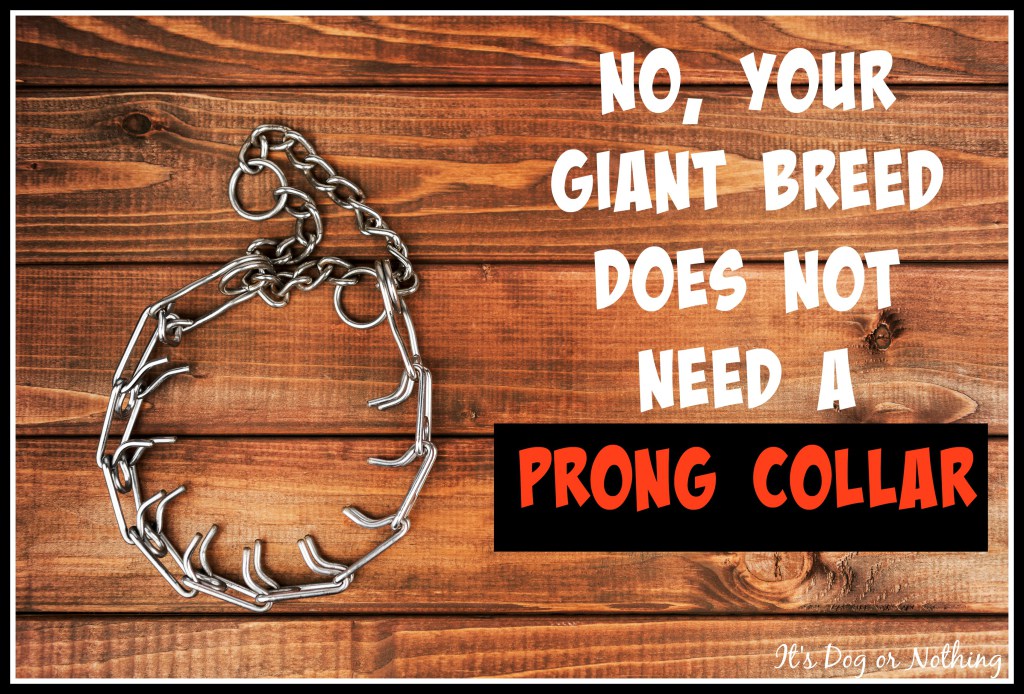
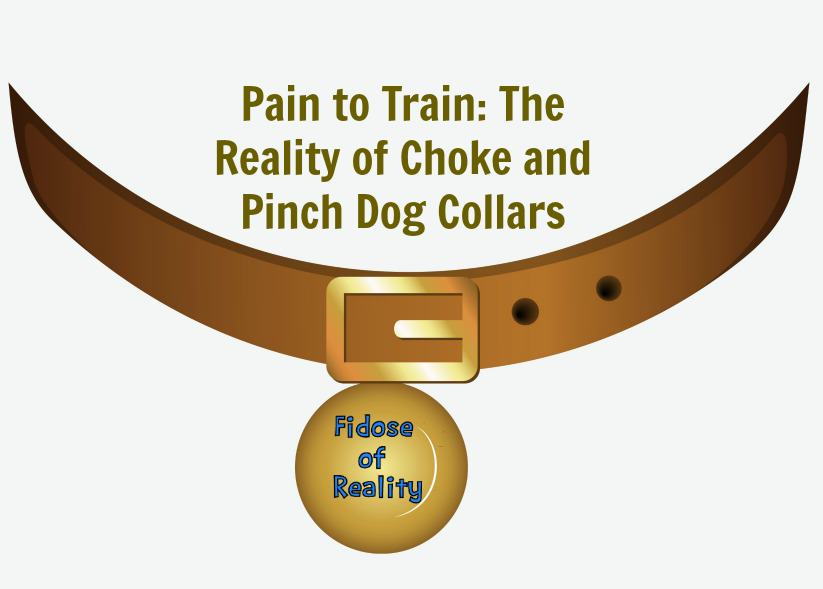
All choke collars are dangerous whether they have prongs or not.
My friend left her coke collars on her 2 large dogs and one’s paw got caught in the others collar and he started choking and when her husband tried to separate them in their panic they bit both of his hands. The news has many instances of collars getting caught on post and fences and hanging dogs. Training collars should only be used when training.
this is very true. Sadly the same can be true for any collar. Closely monitor your dogs when they play together and remove collars if you’re in a safe place to remove all collars do so. Especially if they have a large size difference, a large dog with it’s jaw stuck in a small dogs collar can make it extremely difficult to remove!
Megan, no, this is not true of any collar. I agree that collars should be removed before play and being indoors, especially if you use crates.
I wasn’t saying every collar should be left off when not training, just that any collar can be dangerous when playing. I’s completely unrelated to my disagreeing with your prong propaganda simply spreading important information,
honestly the only reason I left any comments here was to see if the modorators would even let them through. I’m impresed that they did.
Well, Megan, we firmly believe in discussion here – as long as things don’t devolve into insults and name-calling we think everyone has a chance to learn something from it. Many other blogs may not allow differing viewpoints; we think refusing to acknowledge that they exist hurts more than it helps.
Actually, it does relate to it. Strangulation is one of the highest causes of death for dogs and cats alike, being one of the reasons safety collars are recommended or not having a collar on at all in the house. It is also why most modern crates have it imprinted on the bottom to not have dogs in a crate with a collar on. I am just agreeing that any collar can be dangerous in the right circumstances. That being said, prong collars have always been meant to cause pain as part of negative reinforcement training and that is their purpose – to cause harm.
Thankfully I have never seen anyone use these. They look so cruel I could never imagine using one. We use a harness with our very hyper whippet mix and that works well.
The collar seems harsh.
it isn’t, or at least the real one isn’t the bear trap looking one is just some BS they put to make it looks scary. A properly used, quality prong collar is an awesome tool for gentle corrections.
Prong collars are in no way gentle correction – they are meant to cause pain in training, which has been shown countless times in studies to actually be counterproductive. Positive reinforcement is the best sort of training for any dog, no matter what their size and breed.
your studdies are rigged, many all positive dog trainers spread BS then turn around and use balanced training in their paid classes. Try all positive training on an agressive or imbalanced dog and you’re asking for a bite. You’re showing the dog it gets to do what it wants and you’ll give it treats love and cuddles when it feels like them. Do something it doesn’t like an – ouch hello euthanasia.
Scientific, peer reviewed studies aren’t rigged – they are fact. Unlike ‘opinions’, the scientific method has been used in all of these studies, with a control, to show the psychological and physical damage caused by these collars and other forms of pain related training. As well, you rarely see ‘balanced’ training as you call it. These are old school trainers who only care about making money, not creating a happy household for dogs. As for positive training leading to aggressive, I have worked in the rescue community for years and I have NEVER seen a dog through positive reinforcement become aggressive and have seen it GREATLY turn dogs around. If done correctly and not mixed with pain it leads to well adjusted dogs (and cats). They also don’t get ‘treats’ whenever they fell like it, since you seem to think that is how positive reinforcement works. Like human children, it works through showing them that the right actions get rewarded with attention, love, and sometimes treats, while bad behavior is ignored or redirected.
Positive reinforcement training is the only way to go. If you disagree, then I think you have found yourself in the wrong community.
I only commented hear so people who stumble on this page like I did can get an opinion other than yours and don’t scare themselves out of using a valid tool. And I’d love links do those studies because I cannot believe they used the prong collars correctly, I’m guessing they used avoidance training which when done by an inexperienced trainer can destroy relationships with the handler. This is when you give an automatic correction to force the dog to do something and it learns to do it automatically to avoid the correction. I’m don’t support this method or yours, they’re both too extreme. That’s why I say I like a balance. Teach your dog using encouragement, love, treats, and pets. Guide them until they know what is expected and then when you’re sure they know and they just don’t want to listen to you then you can give a mild correction so they know they can’t do whatever they want all the time.
I didn’t say all positive training makes dogs aggressive, I said if you use it on an aggressive dog it reinforces that you do what IT wants, and if you don’t it believes it has every right to bite/correct you. It’s how dogs speak to each other which is why a prong collar works so well. Now I do believe that all positive training reinforces that the dog ranks higher in the pack than humans (particularly kids) I’m not saying it makes them aggressive but if a child starts messing with an all positive trained dog in that dog’s mind it has every right to bark/growl/snap at that child. I don’t think that’s okay, it doesn’t make it an aggressive dog, but it does make it a risk.
Megan,
I’ve been looking into this since the discussion started. I’ll start off by saying that I think you’re right about something – it doesn’t appear that studies have been done on these collars, in particular. That said, the experts I’ve found seem to agree that they work by causing pain – several vets like here, the US Humane Society here, a number of dog trainers (who I won’t bother to cite as you’ve stated you don’t find their opinions to be valid). And given the severe injuries that you can easily find pictures of that they can cause, we know at least some percentage of people who would use these collars INTEND for that pain to happen.
We saw a perfect example of aversive training through pain in action with Ivi as a young puppy – at one point she decided to take down one of our gates to get where she wanted to go, and caused it to fall on her. No lasting injury, but now she knows better than to try – in fact, if she sees us carrying that gate, our normally gentle girl puts her ears back and will run through anything to get away from it, and only feels safe if she’s in a different room from it while it’s moving.
And THAT is where the research has been done – aversive training has been known to work but with potentially terrible side effects. This is something that has been studied by behavior analysts – specifically here’s an excerpt from a book by two who started out under B.F. Skinner, one of the more highly recognized animal behavior analysts of our time, and written after they had studied and trained some 15,000 dogs.
cite: page 28/29, http://bit.ly/2bIeepk
“Aversives in general, and punishment in particular, may have bad consequences for the dog and trainer. They can produce uncontrollable fear, not only of the trainer, but the entire training situation. Aversives can suppress virtually all behavior. They may also encourage aggressive responses. More acceptable alternatives, such as reinforcement, should always be considered before using aversives.”
So if these collars do have a valid purpose, it seems pretty clear to us at least it is as a last-ditch effort to train an otherwise intractable dog, and should involve a professional of some kind…and that it could easily make a dog known to be aggressive even more so – this might well be a last resort before putting down an aggressive animal. I’d even put forward that shock collar training might be more humane, as there is less chance of unintended injury.
i have had big and small dog my chiawiii is a puller and have nto found oller to wrk on her yet she all my service dog
Desiree, I would try the Gentle Leader if nothing else has worked. It does have a little bit of an adjustment period if your dog has never had anything on its face but it works for even the worst of large pullers (aka 200 lb dogs who want to take you for a ride 😉 )
I have seen one of these before, I didn’t know what it was. Thanks for your Post and standing up for the Animals! They are just CRUEL! Would never use something like this, I just bought a new Puppy, so when I read the headline in your Blog, I wanted to see what they were.
These collars scare me. I have little dogs and wouldn’t think of it.
I have never seen these before but it definitely sounds like torture to me. Thank you for sharing alternate methods for training your pet. God Bless
NEVER. Period. No dog should ever be tortured by one of these collars. I work in rescue and the first thing I do when I come across a dog wearing one of these collars is replace it with a safe, appropriate collar and then trash the prong collar. The injuries I’ve seen in dogs who were forced to wear these are horrible.
I agree. I don’t understand how anyone could do this to a poor dog! These collars are horrid!
I DO NOT agree with these collars at all!!!
It hurts just to look at these torture devices. I wouldn’t want one on my neck.
the bear trap looking one, yes, and if someone was caught using one they’d be arrested for animal abuse because it’s total BS. A quality prong collar however is fine. I’ve had one on my neck, it was uncomfortable because my skin is so much thinner than a dog’s but not horrible. I’ve also put one on my arm (more similar in sensitivity to a dog’s neck) and yanked as hard as I could with barely any discomfort. A real correction wouldn’t have been nearly as hard. They’re to get your dog’s attention, not hurt it.
A prong collar is never fine under any circumstance. There is a reason it is banned in many countries outside the United States. It is outright animal abuse. I also honestly do not believe in any way, shape, or form that you ever put on a prong collar or you would know just how painful these collars are for dogs. There are better methods of training that do not involved causing pain.
Have you ever used a prong? If you have I’m guessing it was cheap shitty quality, try a springer prong, they’re great. All three of my dogs have them and my friend’s rottie and puppy. They’re illegal in many places because they are used improperly. No one should ever use a prong collar without knowing how to. Also because of people like you who spread false information
They are illegal because they are a barbaric training tool. I have NEVER used a prong collar because I love and care for dogs. My apologies, but I would much rather use proven training methods backed by science and the majority of professional training organizations.
so you’re spreading false information about a tool you’ve never even seen used let alone used yourself. Super valid. Also I know TONS of professionals who use prongs. “all positive training” is a “politically correct” movement that is used by shitty trainers to draw in clients and make other trainers look bad. Their methods don’t work and can actually make dangerous dogs MORE dangerous.
Susan has seen the results of some people attempting to use these collars firsthand while assisting in an animal shelter, and we as a society accept positions on things that can cause harm without personally trying them (gunshot wounds probably hurt, alcoholism should be avoided, etc). Some people
might
be able to use these collars without causing injury, but a lot of people don’t (not every gunshot wound kills, some people are functional alcoholics). Why advocate for something that causes a lot of injury to dogs, and which may or may not be any more effective than a less-harmful alternative like a walking harness or gentle leader?
Positive training and redirection without pain DOES work and work well for most dogs, outside of an edge cases like a rescued animal with a long history of abuse.
Given what you said before, I’d be very concerned about what happened to your puppy before you got it if you deemed a 2-month old dog ‘dangerous’ and in need of pain redirection through a prong collar.
Just to your “spreading false information about a tool you’ve never even seen used let alone used yourself. Super valid.” comment….I’ve never used a hatchet to cut my infant’s fingernails nor have I ever seen anyone use a hatchet to cut their infant’s fingernails, yet I know, because I’m not an idiot; that a hatchet would be a cruel tool to use to cut my infant’s (or anyone else’s) fingeranails. It is a cutting instrument, though, so you may want to use it on your own fingernails. With proper training, I’m sure a hatchet could be used and do a great job of cutting fingernails. That is all. Prong collars are cruel!
These collars should be banned!
I’ve never seen or heard of these here in Australia, so I’m hoping they’re not very common.
I have never even heard of these collars before. My dogs pull me, sometimes too hard, but I would never use one of those. It’s cruel. I can’t do it.
These things are terrible! I would never use one!
SWeet dogs who would poke them!
My Chessie is over 100# and if you teach them right from an early age there is no need for addition restraints.
Exactly Karen! I have dogs that are nearly 100 pounds and they are sweeties. People don’t understand that all it takes is positive training methods. 🙂
Thank you for using your blog to talk about the barbaric prong collars! I am a rescuer in the South and these torture devices are very common in these parts. I tried many collars/leashes on my personal Pit Bull to try and curb her pulling and purchased a thunder leash as soon as they came available and love it. It is so easy to use and doesn’t require anything additional.
The ThunderLeash truly is amazing, isn’t it? They are common here in Kentucky as well and they make me sick! We really need to ban them.
I can’t imagine even CONSIDERING one of these – it’s so sad. Thanks for educating the world about this!
thank you so much for posting this. we really need to get awareness out to people, i think people are just overwhlemed and dont know what to do
I don’t own a dog, but if I did, I would NEVER use a prong collar or any other device that would cause pain! Thanks a lot for posting!
I would never use these! Thanks for sharing!
I was so nervous to read this until I saw the insert prong collars in the trash!! I absolutely agree!! There are SO many better ways to train your pet!!
Sorry for the scare! I can’t believe there are still trainers recommending these barbaric collars!
Dear God, these are barbaric and anyone who would even think of using one should never own an animal.
I don’t think that these collars are very humane at all, and don’t recommend them.
Agreed. They are horrible and barbaric! I really hope they will eventually be banned in the US.
There is absolutely no reason to resort to prong collars..better early an continued training is required. I am just a pet lover but my niece who is a vet was horrified by this article…her clinic will not even see people’s animals even though it would be beneficial to the animal
Ronald, I am a bit confused – this is anti-prong collar article. I would never in any way condone using one.
Great post!! I would never use a prong collar. It is very damaging to a dog in the many ways you listed. If I wouldn’t want to wear one I sure wouldn’t put one on my dog or any dog for that matter.
NEVER. Period. No dog should ever be tortured by one of these collars. I work in rescue and the first thing I do when I come across a dog wearing one of these collars is replace it with a safe, appropriate collar and then trash the prong collar. The injuries I’ve seen in dogs who were forced to wear these are horrible.
100% agree! We are really hoping that they are someday banned. We are big believers in the PetSafe Easy Walk Harness and the PetSafe Gentle Leader!
Thank you for the tips. I have 3 dogs and need all the help I can get lol
I would never use any collar that can cause pain
they are horrible collars I can not believe people
use them. They should stop making the Prong collars
everywhere and no company should sell them.
I have worked at two vet clinics and I guess I am lucky to have never seen an injury from a prong collar. I always recommend some type of harness to people who need help with dogs who pull!
Ok I’m probably going to piss a few people off here but I have to speak my mind. First off yes there are some very valid point but not entirely true. A prong or correction collar if used correctly can can major benefits. Should a prong collar be used to make your dog look tough or is slightly misbehaved? NO! Should it be used all the time? NO! But that goes with being used correctly. I had to use a prong collar on my dog for several years because when you are walking a 2 yr old 120lb dog that likes to pull and he was really bad too(not mean, bad), you need control. He’s 14 now and I couldn’t have asked for a more perfect dog. He has no psychological issues from it, he’s not fearful if he sees one, he’s fine. He is a lab and dogo mix and would do back flips if I wanted him to. But he just wasn’t coming around like I had wanted and even thought I’d have to get rid of him. I’ve trained dogs and so I thought I just lucked out with a stupid one. But I could see how smart he really was. Every animal is different, learns differently and snaps outta that rambunctious puppy phase. So as a last resort I used a prong collar and I will say it was the best decision I ever made. Before I said he had it for yrs, 5 to be exact. I had tried to switch his collar out but it was like a switch was turned when he had a regular collar and got outside. Everything he knew went right out the window. I’m also not advising anyone to run out and get one because your dog doesn’t listen. It really should be a last resort. A prong collar is not a magical fix and doesn’t work the second you put it on. Animals are like people and not all learn the same way. Try several different methods before opting to go with a prong collar and only use it for walks. Then there’s correction collars or chokers. These can be very helpful and effective if used properly. They are not meant to choke your dog but simply snap the brain outta the state it’s in. It is the noise along with the tug that does that. If you can snap your dog’s neck with it then you probably shouldn’t have a dog and I’d never advise anyone to use it on a small dog, ever!
Hi Melissa,
Thank you for taking the time to respond. I know everyone has different experiences but I am a very strong advocate in positive reinforcement training and redirecting bad behavior. Pain should never be used in training, no matter what the size of the animal. If methods such as harnesses, like the Easy Walk Harness or Gentle Leader doesn’t work, along with CONSISTENT praise of good behavior and redirection of bad, it is usually time to bring in a professional.
As well, it would be worth considering a trip to your vet to make sure there aren’t other underlying issues, such as an injury or fear. Pain training teaching a dog to be terrified of humans and their surrounds that involve the pain, not good behavior.
Yes Susan you are right. I had brought in the professions, $1000 professional, and a trip to the vet. I seriously thought I picked a bad apple. Lol. I had years of training under my belt and many dogs I had trained. But when it comes to a prong collar it really should be a last ditch effort and only if you know what you’re doing. A prong collar shouldn’t NEVER actually inflict actual pain. I am so happy that you did put a post up about the topic because I have seen people that have prong collars on their dog. I usually will ask them why. I can’t tell you how many times I’ve heard because it makes them took tough or they want a mean dog. Also most people use them improperly. So again thank you for having this as a topic. Harnesses are also great tools for a pet.
I am the proud mama of 4 huge pitties & I would never use those prong collars on them they are horrible and not needed at all! Thank you for writing this so I can prove to my husband and everyone else that I was right! ?
The idea is to easily and gently correct a puppy. You don’t want them to think pain is the alternative to Obedience
I can’t believe anyone would even think about using a prong collar. I’m thankful for this review to educate others on how horrible this collar is!!
I am always sad to see a dog that is wearing a prong collar. It causes unnecessary pain. So many other ways to get control instead of resorting to the prong.
I have never believed in using a pronged collar! I know a few people that do use one and I always voice my opinion whenever I see them! There are many other ways to train your dog how to go for a walk properly. I believe a harness works best!
Hate them, its abuse
I can’t even fathom why people would use these torture devices! I could never use them. I believe a positive praise works far better than these! Who would do that to their fur babies? I just never ever could!
I couldn’t either. I always get in trouble when I see dogs in them since I soo want to educate people!
We have a harness that prevents pulling. My dog hated the gentle leader so we got something we both like.
Prong/spike collars scare the crap out of me! I honestly can’t believe that someone would actually use one of their pet, let alone that they are made for them. Thank you so much for sharing the way better alternatives!
I am not a fan of them. There are much better ways to get your dog to behave properly
Thank you so much for writing this. It does promote fear & aggression so those people that say “It makes them look mean” are getting more than they bargained for. Eventually they will not only look mean they will be aggressive. A fearful dog is a dangerous dog. That is why socializing is so important. These should never be used for training. They shouldn’t even be sold
1) I won’t be responding to anything I’m just posting a single comment in hopes that people do proper research.
2) a prong collar is not an anti pull device it is a training collar for mild (yes, mild) corrections if you use one as a no pull device (letting your dog pull till it hurts itself and stops – which it won’t) yes it is abuse and it will get hurt.
3) a quality prong collar (springer is what I use) is completely safe, I can put one on my arm and yank on it and it won’t even bruise. Keep in mind I bruise easy and dogs have extremely thick skin and a HIGH pain tolerance. All this could possibly do is get their attention, it’s not painful at all. A springer prong closes gently, does not pinch, and the tips are rounded. Prongs are a great tool, just be sure to get a quality one.
4) any tool can hurt a dog, a thunderleash tightens around a dogs rib cage, it’s heart. sound like it could hurt? yeah it does. a gentle leader/head haltie can damage or break a dogs neck or the bones in it’s face. a flat collar can choke your dog and damage it’s throat. get my point? all tools CAN hurt, but none of them will when properly used. (except maybe a head haltie if your dog has a tendency to bolt… I don’t like those much)
5) see that prong that looks like a bear trap? that’s abuse and no one in their right mind would use one
6) “makes all dogs fearful/aggressive” my dog came to me with fear and aggression issues from abuse. Using a prong collar has helped me communicate with her. now that she understands me better and listens better it’s so much easier to show her that the world is not as scary as she thinks it is, she is so much happier and balanced. She LOVES her prong, gets excited when I pull it out because she knows it means training and going outside. She’s SO much happier now you would not believe it. Same with our other dogs, they each have a prong and they all LOVE them, the other 2 don’t have bad pasts and they are the happiest most balanced dogs you have ever met. they’ve both been on a prong from 2 months old. they’re fearless, kind, tolerant, and obedient.
to sum it up. prongs are great tools, but like any tool only when used properly. Be careful what prong you buy because a low quality one could harm your dog, also plastic tips pull on the fur you may feel like it’s an extra safety but – ouch. Do your research prongs are a great way to communicate with your dog it’s like a mother’s gentle corrective nip. If you don’t believe me use one on your arm. seriously give it a good hard yank then tell me it’s abusive.
oh one more thing. a prong collar is great if you’re worried about hurting your dogs throat, the spread out pressure points prevent it from choaking
That is 100% impossible. Prong collars are part of a negative reinforcement training routines and are MEANT to cause harm. Fear training is never the right way to go with any dog.
I’m sorry but you’re wrong, I’ve never met a dog on a prong that was hurt by it or fearful of it. Prong injuries are sadly common but that is when a dog is let to pull on the prong and hurt itself until it stops. That is NOT how a prong is used at all, that is abuse, but a prong is a great tool. Trust me I know many dogs who use prongs.
On flat collars you completely validated my point. A fat collar can cause injury when used improperly. Just like a prong
I’ve put a prong on a 2 month old poodle mix and guess what? He is absolutely fearless. One of his favorite things is watching trains rush past him because they’re big and loud. He loves children and playing with his older brother, and the only reason the prong is hard to get on him is he’s so excited he won’t hold still.
You have obviously never been in a shelter or worked with rescue dogs. It is very common seeing dogs severely hurt fro these collars. I know many veterinarians in my own area make clear to their patience that if they are using a prong collar, they have to find a new veterinarian since they do not support such practices. As stated above, I am not proving your point. I am saying that most people use flat collars incorrectly. For dogs that pull, especially puppies, they should be in harnesses that readjust the force of the pull on their body so it does not cause harm to the throat. My preferred training tool with large dogs, like my Alaskan Malamutes, is the Easy Walk Harness.
As for your comment about you putting an 8 week old puppy in a prong collar and dangerous situations like that, I”m sorry, I am absolutely sick to my stomach. The reason this puppy is fearless is because they haven’t reached the fear stage just yet or are starting to enter it. Right now it is trusting of just about anyone. The puppy is also not holding still because…wait for it…it is a puppy. At eight weeks it doesn’t understand much of the world at all, other than mom and its siblings. Causing pain to a puppy that young, especially with a prong collar, is just sickening and pure abuse.
Well yes, it does validate my point. You say “most people use flat collars wrong” and I’m saying “most people use prong collars wrong” Yes injuries happen often when people don’t know what they’re doing and let their dog pull and hope it will hurt itself and stop. That’s not how you use a prong at all. I know someone who worked in a shelter and we’ve talked about the prong injuries she’s seen Yes I know it happens, and yes I do believe laws to regulate prong collars would be a good thing, but no I do not think the tool is bad. I think no one should use one if they don’t know how.
My pup has been through 2-3 fear phases now (5 months yesterday) and still just as fearless and loves his prong just as much, same with our older one (1 1/2 also on a prong from 2 months)
Megan,
Even allowing that you can use one without causing pain/injury or stimulating aggressive behavior (and I’m not at all sure that is true), if people are searching the internet for information on what sort of collar to use, we should assume they don’t have the understanding to use a prong collar the way you say. After all, if they are looking, they obviously don’t *know* about this. Since they probably haven’t tried something like the gentle leader or easywalk/similar training harnesses either, why not start them out on these where they are less likely to hurt or kill a pet that they seem to care about? They control our girls at 50 and 80 pounds, and with no chance that they could end up with a set of puncture wounds.
If a professional tells someone to use a prong collar (and it seems like most won’t anymore), at least a) they really *know* someone who can help them understand how to apply and train with it at less risk of injury, and b) if they do wound or kill their dog it will be on their head, rather than coming from something they read on the Internet.
Megan, I really hope you take your own advice and do some research. Prong collars are banned in many countries and being found using them is pure animal abuse. The ‘gentle nip’ is actually a myth. Pain is never a proper tool in training a dog and there is countless research showing that pain teaches dogs to fear their owners. As well, I am terrified that you view this as a way to communicate with your dog. If your dog has fear/aggression issues, pain in the number one thing you should never do, unless you want to put yourself in a position of being bitten or attacked. I am also curious where you heard that the gentle leader could break a dogs neck. If it is put on correctly and used as directed, it is 100% impossible, being part of the reason many professional trainers prefer it over tools. Please do your dog a favor and do some research about the dangers of prong collars – this isn’t just opinion but fact from decades of research by scientists, veterinarians, and trainers.
trust me I’ve done far more research in reliable sources than you have, otherwise you wouldn’t be saying any of this. The chances of my fearful dog have gone from maybe 50% when startled by a child to maybe 5% She is absolutely not afraid of me in any way shape or form. Like I said she’s excited to get her prong on, she absolutely HATES the gentle leader we tried on her before knowing it was dangerous though. She actually did hurt her neck with it.
Actually, I would love to see your peer reviewed studies and reliable sources that state that prong collars are safe and effective. Most of mine are from peer reviewed, scientific journals that have studies, as well as college level Psychology textbooks. My views on positive reinforcement training (and not using pain methods such as prong collars) come from decades of studies in both animals and humans. You also stated above that your dog is an 8 week old puppy. At eight weeks, they WILL be fearful. It is just their nature as a puppy. I am also very doubtful of your dog being magically fixed by a prong collar, just as you stated that you wore a prong collar. Like that dog, did you wear it and have someone pull on it? Of course not, you wouldn’t be treated that way (btw, yes, crude collars like this were used on some slaves not just in the United States, but other parts of the world).
Most dogs DO NOT love the Gentle Leader. It takes away much of their control when it comes to pulling and redirects them in a way that does not harm them. The only way I can see it causing harm or hurting their neck is if you have it only improperly and are swinging them around on the lead. It is just impossible with how leads are designed. In our family, the Gentle Leader is a last resort with adult dogs since it is hated. Again, not because of pain, but control. For puppies, I prefer the Easy Walk Harness and it works with almost all dogs. I say almost because there is probably dog out there that does better on the Gentle Leader.
Again, if you are against positive reinforcement training, I highly recommend looking at another community. At Budget Earth, we do not support pain methods of training or negative reinforcement.
a properly used prong is an amazing tool for MILD corrections. A quality prong used right will NEVER hurt your dog. I can use one on my arm at full strength and it doesn’t even hurt. It mimics a light corrective mothers bite. Do your research, know what you’re doing, because like any tool they CAN cause harm (there are plenty of scary pictures out there from flat collars but I’ll bet $1000 every one of your dog wears one of those and you’re not abusive are you?
Also that super spikey one that looks like a bear trap. I wouldn’t even call that a prong that’s a torture device.
springer is a great brand btw, go get one for your dog if you think it’ll be helpful to you, my dogs all love them, they helped us turn my dog with a past of abuse into a happy healthy balanced dog. They know the prong means walks and training, 2 of their favorite things.
Megan, prong collars are in no way, shape, or form like a mother ‘nipping’ their puppy. Flat collars are meant mostly for identification and should ONLY be used for walking once your dog is properly leash trained – which means a loose leash, walking by your side, with no pulling.
I am not going to respond for or against prong collars. But I will say that the photo of that pit bull with a prong collar on is not at all how a prong collar is supposed to fit and the way he is wearing it – he will definitely get hurt. I find the photo very misleading.
This was actually professional picture taken and how I have seen many people use these collars. That being said, this was not taken by me.
Okay so I’m replying to a couple points tonight in the responses I’ve got but I only have a few minutes so I’m sure I’ll skip over a couple things and I’ll add stuff tomorrow/actually let people know I responded to them if they don’t see it.
1) Pretty much every profesional in my area, and every one I’ve spoken to who lives at a distance uses prong or E collars with the acception of a few who use gentle leaders
2) When I put my dog on a gentle leader she’d walk then literally crash her face into the cement without warning, or thrash her head around and tweek her neck. Gentle leaders cause dogs to shut down and I find that a lot more abusive than a light jab that says “hey wtf are you doing? stop that”
3) to the guy who compared it to cutting a childs finger nails with an ax or whatever??? That’s like comparing throwing one of those tiny pop rock fireworks at someone’s feet to actually bombing them like wtf are you even saying. Like if something clearly causes harm then yeah, but I’ve litterally said I’ve put these things ON MYSELF LIKE ON MY OWN PERSONAL BODY. I think I know what I’m talking about a little better than your hear-say
4) to whoever said my puppy was aggressive/dangerous and that’s why he needed a prong, he’s not. He’s a SD in training and I’m using the prong as a training tool. It’s a way to speak to him, tell him when we don’t approve of what he’s doing and he should change his behavior. We use it because it’s a great tool that’s far more humane than a haltie or straight up choke collar (worry about their throat) and a harness doesn’t provide any sort of correction, just prevents pulling which he never did anyways. He is never ever hurt by his prong, like I’ve said a thousand times and for some reason you guys don’t seem to understand that I have a ton of first hand experience. THEY DON’T HURT.
5) I’m not a part of this community, I came to spread my knowledge to people open to listen because talk like what I see here gets me mean looks from people that I do not deserve. If someone hurts their dog with a prong collar (which is not easy to do) It’s because they’re a careless owner that I can promise you would have hurt their dog in some other way without it. It’s not something you can do by mistake.
6) out of time I’ll try to get to more stuff mentioned tomorrow, if you have something specific you’d like me address respond here and I’ll happily do so.
Megan,
I think a few of those were actually me (specifically 1, 2, and 4). I admit, you’ve got me a bit confused – if the collar doesn’t use pain to ‘talk’ to the dog, what is it doing, exactly, that a collar or harness without metal prongs wouldn’t do? It even seems like you acknowledge it (at the end of your second point, a ‘light jab’ is still pain in my book) but then claim they don’t hurt if you pull on it (in point 4). You said you’ve put one on – did you have someone pull on it? Did you lean on it with 50-80 lbs of pressure, the way that a dog (at least one the size of our Ivi or Riley) would, and really have no pain or discomfort at all? What about having them yank on it, the way someone who has no idea what they’re using might, if they have a dog who doesn’t walk nicely? Realize those are the sorts of things that someone who is looking for this sort of information is entirely likely to do, if they have no training or experience in using a collar like that.
As to the puppy, that was how I read what you said. You said that all positive training could lead to an aggressive dog assuming they have dominance over you (which, as I said last week, I can see being the case with an animal that is already abused and aggressive). Because of that, if you’re having to resort to something which relies on pain to assert your dominance over their behavior, I’m assuming you’re working with an aggressive animal.
have you ever seen kids play? Like rough housing? They can be pretty rough, but they don’t get hurt, or at least not at first. They can poke and prod and jab at each other and not hurt, if they do they’ve pushed it too far and kids will be kids, but I’m talking about before that, when it’s simple play and no one’s hurt. That’s what a prong’s like. It’s a jab, yeah, but it’s not painful. You can shove a friend to get their attention without hurting them right? It’s like that. If you hurt your dog you’ve pulled too hard.
If you get 50-80 pounds of force on a prong you’re an idiot, you’re not using it right, and you’re going to hurt your dog just like you would doing that on a flat collar. Like I said I’m ALL FOR laws saying you need to learn how to use a prong before you can have one. Just because you can hurt a dog with a tool, doesn’t mean the tool is bad, it means if you hurt your dog you’re irresponsible. That’s your fault, not the tools. Who in their right minds would think you could put a prong on a large dog’s neck and let it pull on it? I actually know many prongs will actually break open if you let a dog do that.
I’m talking about training as a whole and using my experience with my dogs as an example. All my dogs have prongs, my oldest (8yo malinois lab mix) was abused and used to have major fear aggression issues. The prong has helped INSANELY with this, not by making her scared to react to things that scare her, but by teaching her that reacting is the wrong course of action and that there is in fact nothing to fear.
My goldendoodle pup has been on a prong his whole life with us because it’s a great tool. He (nor are other dogs) are ever hurt by it or scared of it.
Megan,
50-80 pounds of force wasn’t a random choice for my example. Those are the weights of our girls, and when they decide it’s time to chase something, or hear a sound that scares them, that’s the force we can expect to hit the harness at least briefly, until they remember we’re walking. If we were to suddenly switch Ivi or Rylie to a prong collar, it’s the sort of force that would presumably end up on those prongs around their neck
at least
once – and I can’t imagine that that sort of pain or injury would be calming or seen as a reason to be less afraid of anything.
In the end, though, the point I’ve been trying to stress, and the one addressed in the article, is one that you seem to agree with – random people without training and experience using these collars, who are looking for a means to better control their pet, should NOT be looking at these as a safe or simple option to use. Personally, I can’t see why anyone would view it as an ideal or starting tool – Susan and I have both had external causes that made us drop a leash at least once, and having a prong collar could easily have turned catching one of our girls into a vet trip when we did get the leash back, if they didn’t want to stop.